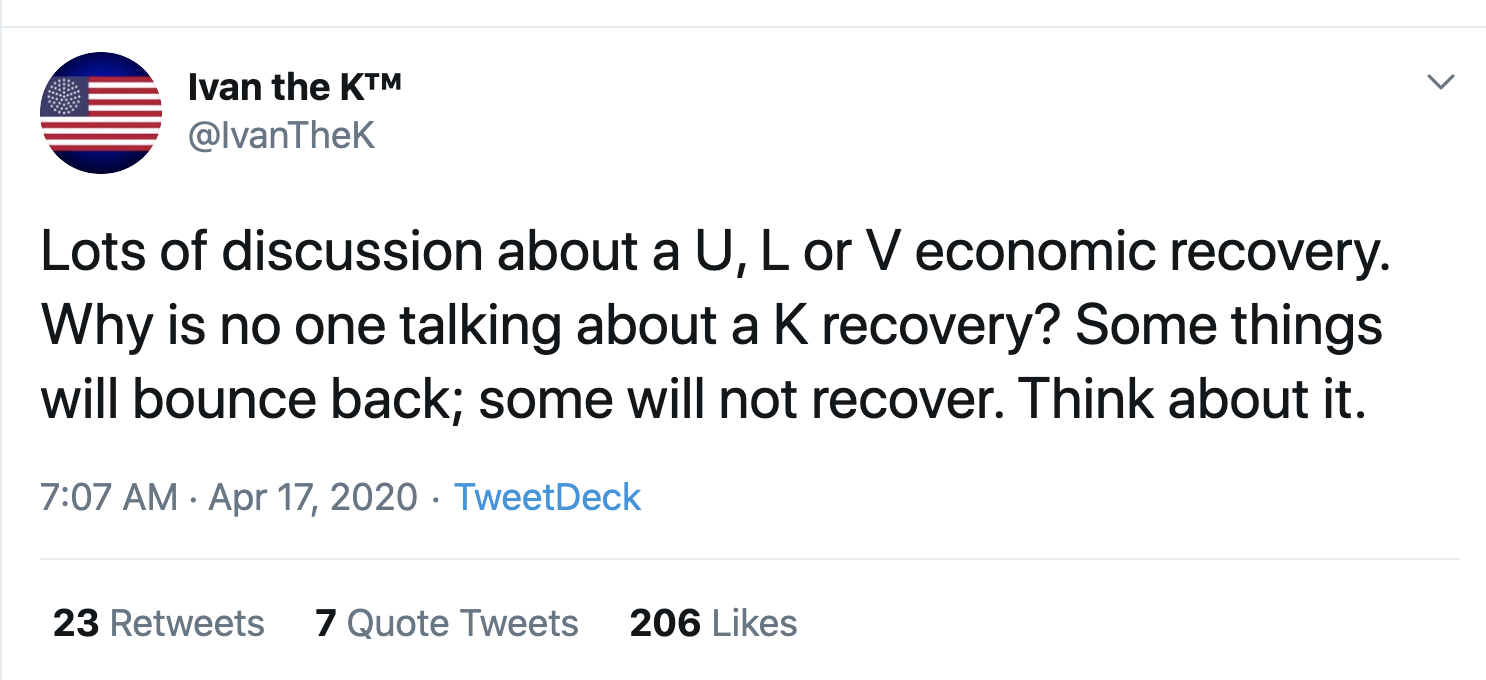Sadly, One Letter Perfectly Captures the Recovery
It is silly to use only one letter to describe the economy. This time, one letter seems to work.
Bloomberg, September 2, 2020
Lots of discussion about a U, L or V economic recovery. Why is no one talking about a K recovery? Some things will bounce back; some will not recover. Think about it.
— Ivan the K™ (@IvanTheK) April 17, 2020
In the aftermath of the Great Financial Crisis, I received an extremely silly email: It was from a TV show booker who, during the early days of the 2009 recovery, asked: “What single letter would you use to predict the recovery?”
Aghast, my response noted there are 26 letters which humans, unlike other animals, could use to form words and even sentences to express complex thoughts. Rather than dumb down something as intricate as the economy to a hieroglyphic cave painting, why not use the full majesty of the English language to communicate nuanced ideas? Respect your viewers’ intelligence, use prior recoveries as an historical guide, acknowledging all the while our inability to forecast the future. Why, we could even add numbers to those words, explaining probabilistic assessments and possible future outcomes – so superior to predictions!
The email response was priceless: “So, no letter?”
I was reminded of this courtesy of the many recent discussions on “U” and “V” and “L” and “W” shaped recoveries. My favorite is the “Nike Swoosh” recovery – which may very well be a letter somewhere in the Milky Way galaxy, but here on earth represents instead the triumph of brand marketing rather than an alphanumeric example.
“K” has since shoved aside of these discussions.1 If you were to describe the 11th letter in the English alphabet to someone who has never seen it, you would note it is distinguished by a bold vertical line, from the midpoint of which begins two rightward traversing lines, one slanting 45 degrees upwards from the horizontal, the other, 45 degrees downwards.
This description of the economy fairly captures the two separate paths of the recovery.2 The line heading upward symbolizes those parts of the economy that have benefited from pandemic: Technology (Apple Inc., Alphabet Inc., Microsoft Corp.), general merchandise retailers (Target, Walmart), entertainment (Netflix Inc., Walt Disney Co., YouTube), Biotech and Pharmaceuticals (Moderna Inc., Johnson & Johnson & Johnson, Merck & Co., Pfizer Inc., AstraZeneca PLC) work from home firms (Slack Technologies Inc., Zoom Video Communications Inc.) and online retailers (Amazon.com Inc., Shopify Inc.).
The line heading downward symbolizes, well, pretty much everyone else. We see this reflected in how various S&P 500 Index sector funds have performed. Technology (Technology Select Sector SPDR Fund), Communications (Communication Services Select Sector SPDR Fund), and Consumer Discretionary (Consumer Discretionary Select Sector SPDR Fund) are up 31.6%, 18.4%, and 16.9%. The three worst performing broad sectors, Energy (Energy Select Sector SPDR Fund), Financials (Financial Select Sector SPDR Fund), and Utilities (Utilities Select Sector SPDR Fund) are down 40.3%, 18.7%, and 8.2%.
As much as I despise the “single letter” silliness, it’s a reminder of a truth about the economy: over the past four decades, the U.S. has become a nation that has seen the benefits of economic growth, productivity and innovation accruing to fewer and fewer people. Once a nation of “Haves” and “Have Nots,” we are now a nation of “Haves,” “Have Nots,” and “Have Much More.” The last category has left the first two in the dust.
This is no longer a debate. A few cranks on the extreme right may pretend it’s not true, but the data is overwhelming. The portion of national income received by workers fell from 64.5% percent in 1974 to 56.8% more recently. The pandemic and lockdown have only a bad situation even worse. Both income and wealth distribution has become so lopsided that even its most ardent critics underestimate how disproportionate it is in America (as well as much of the rest of world).
The more important question facing economists, investors, policy makers – and in about 60 days, voters – is simply this: Have the past 40 years of income and wealth inequality become structural elements of our economy? Can this problem be fixed with modest tweaks to the tax laws and safety net (pre-existing condition coverage, Medicaid, etc.) Or, has something fundamentally broken in the American economy requiring substantial changes to address?
We have discussed this repeatedly since the post-financial crisis recovery began in 2009. That recovery was very lumpy and unevenly distributed. The key wage drivers were determined by the industry you worked in, your geographic location and your level of education. If you were in the right sector near a successful city with a college or graduate degree, you did quite well. The rest of the labor force mostly struggled.
And that was before the pandemic. If you disliked how the last economic expansion unfolded, you are going to really hate the next one, as the economic divide has become even steeper. All of the factors impacting wages and employment are now more pronounced. Economically, there has never been a worse time to be high school dropout in America. Workers with more education simply have lower unemployment rates, according to the Bureau of Labor Statistics. They also earn more money. This gulf is likely to widen even further in the future.
I am forced to admit that the letter “K” captures the coming recovery in its simplest form.
Previously:
The Bifurcated Recovery in Jobs (November 12, 2013)
Our Bifurcated Recovery (August 27, 2014)
The Bifurcated Economic Recovery Continues (June 5, 2019)
_______
1. The earliest reference I could find to a K-shaped recovery was April of this year.
2. We discussed this recently: “Why Markets Don’t Seem to Care If the Economy Stinks” and “Big Tech Drives the Stock Market Without Much U.S. Help.”
~~~
I originally published this at Bloomberg, September 2, 2020. All of my Bloomberg columns can be found here and here.


